Catocala relicta
Catocala relicta
kah-TOCK-uh-lah mreh-LIK-tuh
Walker, [1858]
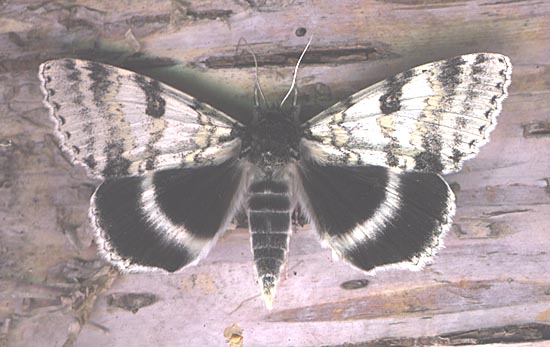
Catocala relicta, (form clara) posed scan on white/paper birch by Bill Oehlke,
Montague, Prince Edward Island, August 23, 2002.
This site has been created by
Bill Oehlke.
Comments, suggestions and/or additional information are welcomed by Bill.
| TAXONOMY:
Superfamily: Noctuoidea
Family: Erebidae, Leach, [1815]
Subfamily: Erebinae, Leach, [1815]
Tribe: Catocalini, Boisduval, [1828]
Genus: Catocala, Schrank, 1802
|
DISTRIBUTION:
The Forsaken, White or Relict Underwing,
Catocala relicta (wingspan: 70-80mm),
flies in all Canadian provinces (rare in Newfoundland) and also in
the Northwest Territories.
In the United States it occurs in the border states
(Washington [Robert Goodmiller, September 2002];
Montana [Charles Miller, Missoula Co., August]; and eastward)
and has been taken as far south as Missouri, and in
Kentucky and
Mississippi as strays.
It flies in
Colorado and
Utah.
Tom Middagh reports them in Minnesota.
Arizona,
California,
Connecticut,
Idaho,
Illinois,
Indiana,
Iowa,
Maine,
Maryland,
Massachusetts,
Michigan,
Nebraska,
Nevada,
New Hampshire,
New Jersey,
New Mexico,
New York,
North Dakota,
Ohio,
Oklahoma,
Oregon,
Pennsylvania,
Rhode Island,
South Dakota,
Tennessee,
Vermont,
Virginia,
West Virginia,
Wisconsin and
Wyoming.
Scott Shaw reports relicta is common
"on Pole Mountain, in the Medicine
Bow Forest, Wyoming, about 10 miles east of Laramie near I-80 in
the mountain willow bogs."
The moth formerly described as C. elda Behrens 1887, is now a synonym of C. relicta.
Visit Catocala relicta, Hat Rock State Park, Umatilla, Umatilla County, Oregon, August 1, 2009,
courtesy of Mike Denny.
Visit Catocala relicta approaching bait trap, plus recto and verso images and comparison plate, Regina, Saskatchewan,
August 17, 2009, courtesy of Tim Taylor.
Visit Catocala relicta form phrynia, Ogemaw County, Michigan, August 26, 2012, Cindy Mead.
Visit Catocala relicta, Hinckley, Somerset County, Maine, August 30, 2011, Steve Lemieux.
Visit Catocala relicta, Oscoda, Michigan, September 3, 2019, Gloria Beckstrom.
Visit Catocala relicta, Stillwater, Sussex County, New Jersey, September 4, 2019, Joe Garris.
Visit Catocala relicta form phrynia, Peterborough, Ontario, September 7, 2004, Tim Dyson.
Visit Catocala relicta, Athol, Worcester County, Massachusetts, September 29, 2011, Dave Small.
Visit Catocala relicta, forms: typical and clara, Medford, Taylor County, September, October 1-2, 2011,
Joan F. Rickert.
Visit Catocala relicta male verso,
unusual leg spines, Regina, Saskatchewan, November, 2009, courtesy of Tim Taylor.
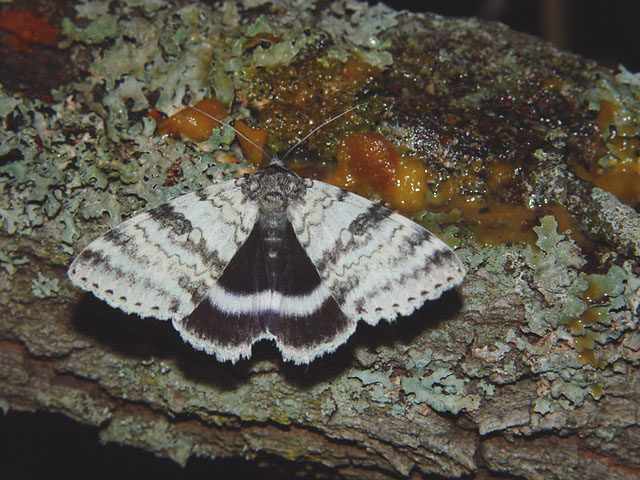
Catocala relicta, form "clara" Peterborough, Ontario,
August 16, 2004,
courtesy of Tim Dyson copyright.
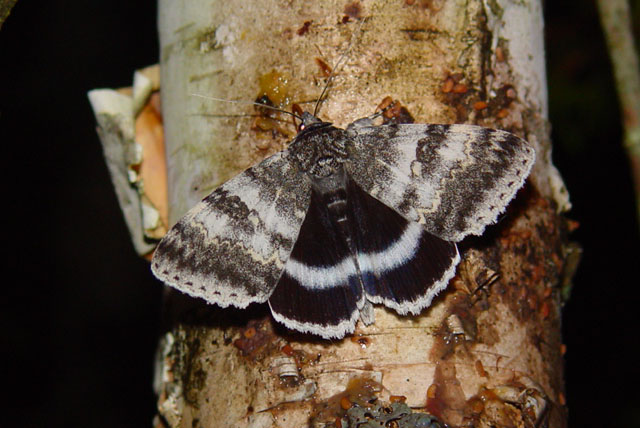
Catocala relicta, Peterborough, Ontario,
August 27, 2004,
courtesy of Tim Dyson copyright.
Studies indicate that adult moths definitely chose light coloured
surfaces on which to hide. There is considerable variation with regard
to black/white concentrations on the forewings.
The form clara Beutenmüller, 1903, has the basal and subterminal areas
predominantly white; the form phrynia Henry Edwards, 1880, is evenly dusted
with grey over the entire forewing.
Typical specimens (right) have the basal and subterminal areas filled with
blackish scales. Catocala relicta, Peterborough, Ontario,
August 28, 2004, Tim Dyson copyright. | 
|

Catocala relicta form "phrynia", Peterborough, Ontario,
August 21, 2004,
courtesy of Tim Dyson copyright.
Visit Catocala relicta form "phrynia", Wolf Creek, Josephine County, Oregon,
August 22, 2009, courtesy of Edna Bottorff.
I was out tending some of my
Saturniidae larvae in big white remay sleeves in a stand of poplars
and birches around 4:30 pm today, September 2. There was a nice
female relicta form clara resting on the side of one of the
sleeves.
Examination of the ventral tip of the abdomen is not a good way to
sex these moths as the appearance was of claspers, i.e.,
there was a "split" in the abdominal hairs at least 3 mm long from
the tip of the abdomen toward the head. The frenulum should be inspected.
Males have a single, thick spine, while females have multiple softer spines. |

Male Catocala relicta by Bill Oehlke. |
FLIGHT TIMES AND PREFERRED FOOD PLANTS:
Catocala relicta are on the wing from late June to October.
The Catocala relicta caterpillar feeds on poplars, quaking
aspen and willows. It has also been reported on oak, hickory and birch.
ECLOSION:
Adults eclose from pupae at soil surface.
Those that I have reared from eggs have spun very loose cocoons
among leaves. Form "clara" seems most common on Prince Edward
Island in the Montague area. Eggs from "clara" females have yielded
"clara", typical and "phrynia" forms.
SCENTING AND MATING:
Catocala relicta females
emit an airbourne pheromone and males use their antennae to track the
scent plume.
This moth is reported to mate readily in captivity.
The abdomen of the female reminds me of a turkey baster while males have
a much more even taper.
EGGS, CATERPILLARS, COCOONS, AND PUPAE:
Eggs are deposited on
tree bark in the fall and larvae emerge the following spring.
I captured several
females at lights and they readily oviposited in inflated brown paper
grocery bags. Eggs, very small, were deposited along sides, but most
often near top where bag had been folded shut. I had also inserted a
crumpled up brown paper sandwich bag and found eggs in creases/folds
on outside of the bag as well as inside the bag. It seems moths
seek out sheltered spots in which to oviposit, either to protect
themselves or eggs. |  |
I am extremely grateful
to Kirby Wolfe for his photographs of Catocala eggs.
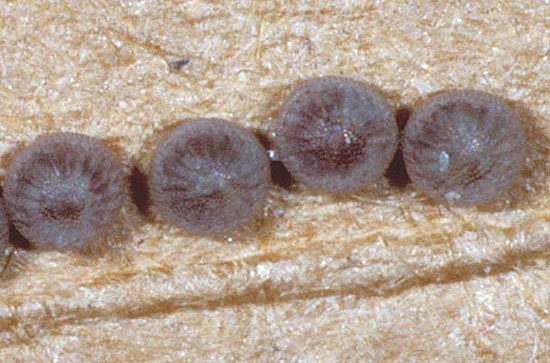
Catocala concumbens courtesy of Kirby Wolfe

Catocala relicta
courtesy of Kirby Wolfe.
The eggs look like miniature pin cushions, well rounded, but slightly
flattened with intricate sculpting.
The pale greenish-grey larvae attain lengths of 60 mm. The head is brown
and coarsely granulose.
Success! The Catocala relicta and
Catocala concumbens eggs that I overwintered in the refrigerator
crisper provided me with many tiny caterpillars this spring.
They are very tiny, yet very quick, moving in a jerky "inch-worm"
fashion, reminding me very much of the movement of disturbed
mosquito wigglers.
Larvae progressed very rapidly in outdoor remay sleeves on poplar and
attained a length of about 60mm (2-1/4 inches) by July 18. They are masters of
camouflage, hugging the poplar limbs.
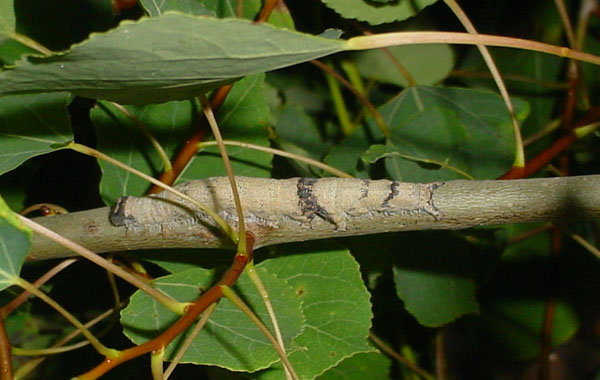 I got a surprise when I took them indoors to finish them in large plastic tubs.
This species makes a cocoon, utilizing silk, leaves and whatever debris is nearby.
In the wild, larvae probably descend the tree to spin amongst leaf litter; in the
tubs, cocoons were spun up amongst leaves still affixed to twigs.
I got a surprise when I took them indoors to finish them in large plastic tubs.
This species makes a cocoon, utilizing silk, leaves and whatever debris is nearby.
In the wild, larvae probably descend the tree to spin amongst leaf litter; in the
tubs, cocoons were spun up amongst leaves still affixed to twigs.
Cocoons were not much smaller than luna cocoons even though larvae were not
near the bulk of mature luna caterpillars. Pupation followed within a couple of
days and there is an interesting "bloom" on the outside of the
pupae.
The first cocoons were spun on July 19 and the first eclosion was on
August 8. This, I believe,
is too early for the natural flight here on P.E.I. Next year I will
not takes eggs out of cold storage until at least three weeks after
poplar leaf out.
Below are two images of larvae on Big toothed Aspen, New Hampshire,
courtesy of Ron Nelson.

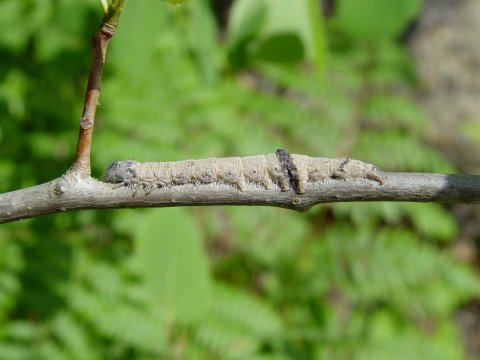
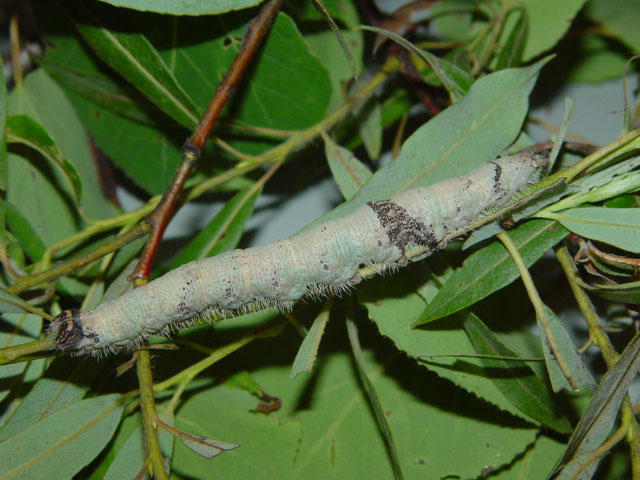
Catocala relicta courtesy of Tim Dyson.
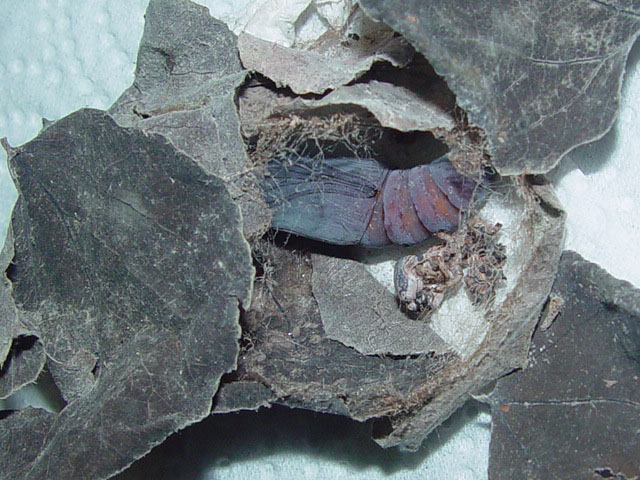
Catocala relicta pupa in cocoon, courtesy of Tim Dyson.
Larval Food Plants
Listed below are primary food plant(s) and alternate food plants.
It is hoped that this alphabetical listing followed by the common
name of the foodplant will prove useful. The list is not exhaustive,
although some species seem very host specific.
Experimenting with closely related foodplants is worthwhile.
|
White/paper birch
Shagbark hickory
White poplar
Balsam Poplar
Eastern Cottonwood
Lombardy Poplar
Quaking Aspen
Oak
Willow
Diamond Willow
|
This page is brought to you by Bill Oehlke and the
WLSS. Pages are on space rented from Bizland. If you would like to become a "Patron of the Sphingidae/Catocala Sites",
contact Bill.
Please send sightings/images to Bill. I will do my best to respond to requests for identification help.
Enjoy one of nature's wonderments: Live Saturniidae (Giant Silkmoth) cocoons.

|

To show appreciation for this site, click on the flashing
butterfly to the left, a link to many worldwide insect sites. |















